QUESTION
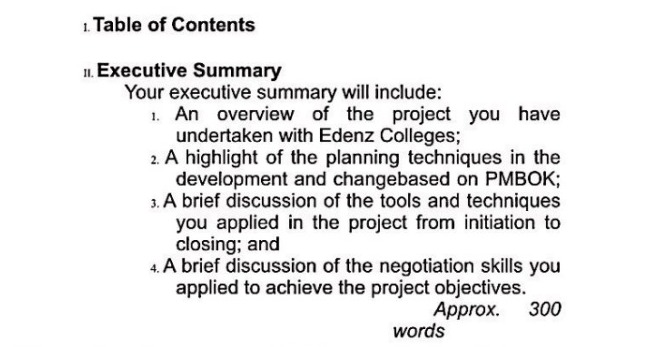
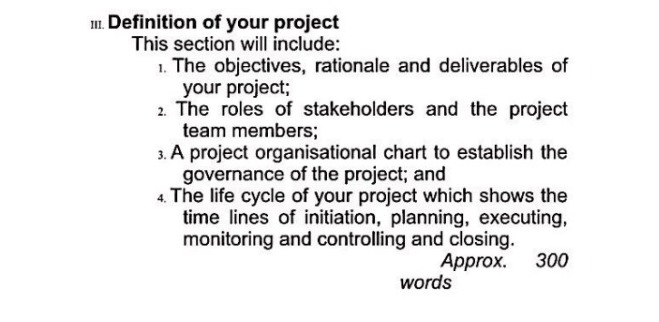
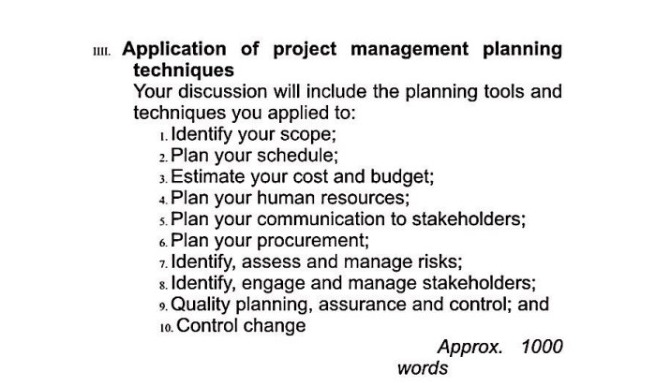
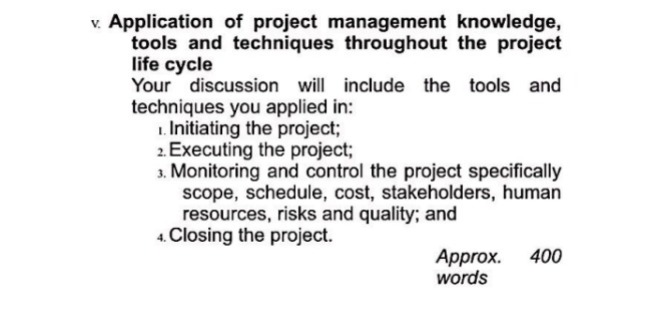
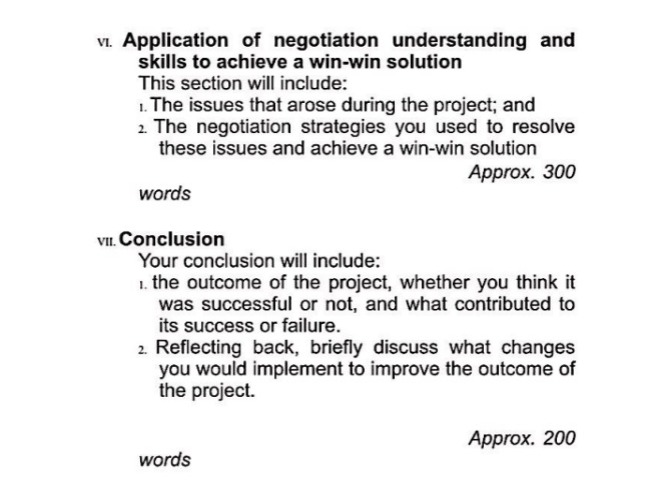

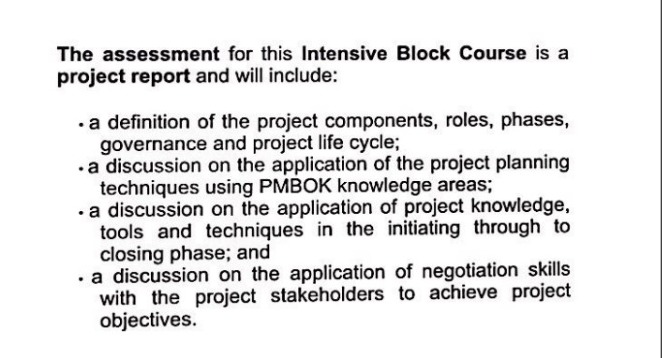
ANSWER
FUNDAMENTALS OF PROJECT MANAGEMENT
Table of Contents
II. Executive summary
1. Overview of the project:
2. Planning techniques of project development
3. Tools and techniques for initiation and closing
4. Negotiation skills to achieve project objectives
III. Definition of the project
1. Objective, rationale and project deliverables
2. Roles of stakeholders and team members
3. Project organizational chart:
4. Life cycle of the project
IV. Application of project management planning techniques
1. Project scope
2. Project schedule plan
3. Cost and budget estimation
4. Human resource plan
5. Communication to stakeholders
6. Procurement plan
7. Identification and managing risk
8. Stakeholder management
9. Quality planning
10. Control change
V. Application of project management knowledge, tools, and techniques
1. Project initiation
2. Project execution
3. Monitoring and controlling the project
4. Closing the project
VI. Application of negotiation understanding and skills to achieve a win-win solution
1. Issues during the project
2. Negotiation strategies to resolve the issues
VII. Conclusion
1. Outcome of the project
2. Recommendation
VIII. References
IX. Appendices
II. Executive summary:
1. Overview of the project:
This report is aimed to develop a project management plan for a sports tournament that is going to be organized at Edenz College. Project management team will communicate with the key stakeholders of the project and will the shareholders for approval of the project. Apart from that, a proper strategic planning will be done to drive the project successfully. The management team will use proper technique to analyse the techniques of assessing risks. Moreover, risk mitigation plan will also include in this project.
2. Planning techniques of project development:
Project planning should be done precisely. As stated by Papke-Shields & Boyer-Wright (2017), strategic planning is based on competitive theories that can help an organization to achieve the objectives of the project management plan. PMBOK is a project management method that can break the project work in five steps. As per the PMBOK guidelines, the project plan will be executed following the techniques named, initiating, planning, executing, controlling and closing.
3. Tools and techniques for initiation and closing:
Project initiation phase can be considered as the most crucial phase of a project management plan. In this phase, the lifecycle and deliverables are decided. Among the entire phases project planning can be considered as the most important step (Tesfaye et al. 2017). In that aspect, as an initiation tool, Google docs can be used. Another effective tool that has used in this project is Gantt Project (Sharon & Dori, 2017). For closing the project data analysis is one of the most important parts.
4. Negotiation skills to achieve project objectives:
In order to drive a project successfully project management team has good negotiation skill. In order to develop this project plan for a football tournament, the management team should have the ability to set the goals and limits of the project. They need better communication skills and have to control their emotional state while working in a team.
III. Definition of the project
1. Objective, rationale and project deliverables
Objectives of the project are
- To raise fund to donate
- To raise awareness of sports
- To attract young people
This project is aimed to increase awareness of sports among young people. In this current age young generation are getting engaged in technology-based lifestyle. In this aspect, this project is focused to attract young people to play football. Apart from that, it is a fundraising project too. Collected fund will be donated to an orphanage home.
Key deliverables of this project are to increase the awareness for sports among young generation along with implementing a social impact.
2. Roles of stakeholders and team members
In order to develop a project plan, stakeholders and team members can play a key role. As opined by Lin, Ho & Shen. (2017), stakeholder can influence the project plan and help the team members in decision making. The key stakeholders of a football tournament are, the participants, the spectators, sports governing bodies and the investors. As it is football tournaments, the participants and the spectators are the major stakeholders as without them the project cannot be completed. The sport’s governing body has the authority to approve the project plan and the money need for the tournament will be supplied by the investors. The project management team members are responsible for organizing the event and approaching the stakeholders to involve in the project.
3. Project organizational chart:

Figure 1: Project organisational chart
(Source: influenced from pmi.org, 2019)
4. Life cycle of the project
|
|
Days |
|
Football Tournament |
78 (total) |
|
Project Initiation |
16 |
|
Complete Kickoff Party |
1 |
|
Launch Event Website |
4 |
|
Contact teams |
10 |
|
Announce Final Brackets |
1 |
|
Project Planning and Implementation |
30 |
|
Recruit Referees |
3 |
|
Arrange Venues |
5 |
|
Plan Fixtures |
5 |
|
Pursue Sponsorships |
4 |
|
Conduct Promotion |
10 |
|
Print and Sell Tickets |
3 |
|
Project Execution |
17 |
|
Organise Events |
1 |
|
Complete First Round of Games |
7 |
|
Complete Second round |
7 |
|
Crown tournament champions |
1 |
|
Announce other winners |
1 |
|
Project Monitoring |
4 |
|
Tracking events during tournament |
1 |
|
Checking any issues during events |
1 |
|
Checking weather reports and changing fixtures |
1 |
|
Maintaining a Contingency plan |
1 |
|
Project Closure |
11 |
|
Give payments to referees |
1 |
|
Reach 50% of donation goal |
5 |
|
Reach 100% of donation goal |
4 |
|
Close the project |
1 |
Table 1: Life cycle of the project
(Source: influenced by Stout et al. 2018)
IV. Application of project management planning techniques
1. Project scope
|
Scope description: |
|
|
Acceptance criteria |
This project is required to be accepted by the sport’s governing body. Apart from that, the investors of the project have to approve the plan and invest money. Team members have to convince the students to participate in the tournament. |
|
Constraints |
The management team might not get enough funds to donate. Investor might not show any interest in this kind of project. Teams might not be prepared to participate in a fundraising tournament (as influenced by Othman, Shafiq & Nuruddin, 2017). |
|
Assumptions |
Financial assumption: All the teams will pay $150 as an entry fee within the scheduled time. Investors will appreciate the plan and involve spontaneously. Personnel assumption: Students of the universities will show interest in this project. The sport’s governing body will allow the management team to execute the plan. The project will be approved by all the key stakeholders. |
Table 2: Project scope
(Source: influenced form news.ibqmi.org, 2019))
2. Project schedule plan
[Refer to Appendix 1]
3. Cost and budget estimation
|
Objectives |
Budget |
|
Location rental |
2500 $ |
|
Equipment |
1350 $ |
|
Lights |
400$ |
|
Security |
525$ |
|
Prizes |
1500$ |
|
Advertisement |
2500$ |
|
Meetings |
300$ |
Table 3: Project budget
(Source: influenced from umsl.edu, 2019)
4. Human resource plan
Human resource is one of the most important things in order to develop a project management plan. As this project is focused to develop a fundraising football tournament, several human resource executives are required to execute the different part of the project plan. The project manager is responsible to supervise the overall project management plan. He is the key personnel who have the authority to approve the project plan.
The operational director will manage the performance of the team managers. They will check the day to day activities and growth of the project. The fundraising coordinators will be responsible to engage all the stakeholders and approaching the investors to invest in the tournament (as influenced by Kianto, Sáenz & Aramburu, 2017). They will be responsible to organise all the fundraising activities.
The compliance manager will be responsible to determine if there is any aspect of the project is in violation of the agreements with the authority.
The financial manager will look after the budget of the project. He will be responsible to identify the expenses of the project and according to that budget approach the investors.
5. Communication to stakeholders
|
Message |
Description |
Audience (stakeholders) |
Method |
Frequency |
Sender |
|
Kickoff Meeting |
To discuss the project plan |
All stakeholders |
Face to face communication |
Once |
Project manager |
|
Project charter |
Approval to start the project |
Managers of the project |
Social media |
Once |
Management head |
|
Project Scope statement |
Describing the project budget, time scheduling, and resources |
All stakeholders |
Sending softcopies via e-mails and social media |
Once |
Project manager |
|
Project risk management plan |
Identifying the risks and mitigation plan |
Managers |
Face to face meetings |
Once |
Project manager |
|
Event awareness |
Promoting the tournament to raise awareness and attract participants |
Media, participants, and outlets |
Social media, Newspaper Media and leaflets |
Daily |
Marketing manager |
|
Event finalization |
Finalizing the tournaments schedule and other plans |
Participants, managers, volunteers |
Conversation over phone, e-mails, and websites |
Once |
Operations director |
|
Day 1 result of the tournaments |
Producing the results of the 1st day and preparing the schedule of the 2nd day |
Participants, team managers, and volunteers of the tournaments |
Face to face conversation and phone calls |
once |
Event organisers |
|
Final event |
Reports of the final match, winning celebration, reports of the donation amount |
All the key stakeholders |
Face to face communication |
Once |
Event organisers |
|
meeting |
Project growth review |
Team members |
Face to face communication, social media, phone calls |
As per requirement |
Project manager |
|
Tournament winner |
Information about the winning team and prize distribution |
Important stakeholders |
Phone calls |
As per requirement |
sponsor |
|
Project termination |
Ending the project, releasing the stakeholders |
All key stakeholders |
Face to face communication |
Once at the end |
Project manager |
Table 4: Communication plan
(Source: influenced from umsl.edu, 2019)
6. Procurement plan
The project plan will require procurement contracts from different vendors. The future of the project is depending on the skills and ability of the management team to procure all the materials of the project. The suppliers will be approached to supply the equipment need for the tournament along with the jerseys of the player, food and other additional requirements. As this is a fundraising project and this project has a social aspect, student and faculties of Edenz College must design the project in a way that can attract the investors (as influenced by Di Maddaloni & Davis, 2017). They have to be strategic to decrease the budget of the sponsors in order to influence them to invest money in this project.
7. Identification and managing risk
Identifying the risk of a project is an essential part of the project. As opined by Sgouras et al. (2018), the key factors of a risk management plan of a project include identification, qualification, monitoring, and controlling of the risk. In order to identify the risk, a risk register can be maintained by the project management team. In this project, the management team will prepare a risk breakdown structure that will help to categorize the risk. These risk breakdown structure will include, brainstorming, assumptions and constraints, interviews and historical information. Required information to analyze the risks will be collected from previous projects for football tournaments and fundraising.
8. Stakeholder management
Stakeholders are the key personnel in a project management plan. The project work cannot be continued without the participation of the stakeholders. Therefore, stakeholder management plan includes,
- Identifying the key stakeholders: The project management team will identify their key stakeholders and will approach them to involve in the project.
- Seeking feedback from the stakeholders: The project managers will approach the stakeholders and request them to provide their feedback on the project. This can help the project management team to identify the growth of the project along with identification of upcoming risks (as influenced by Parent, 2017)
- Incorporate the feedbacks in the project plan: The project management team will incorporate the feedback from the stakeholders in their project management plan to improve their project work.
- Report back: The project management team will communicate with the stakeholders on a regular basis to inform them about the progress of the project. They will inform the stakeholders by organizing meetings or using other communication media.
9. Quality planning
In order to maintain the quality of the project, the management team will monitor the project on a regular basis. Proper communication with the stakeholders and the team members will help the management team to identify the loopholes of the project and maintaining the quality of the project.
10. Control change
In order to change the project plan in between the project progress, the management team will have to prepare a proper document of the required change of the project. In that document, they will mention the need for the change and it’s important. The change document will send to all the key stakeholders and the change will be implemented with the approval of stakeholders.
V. Application of project management knowledge, tools, and techniques
1. Project initiation:
Google docs and Gantt project can be used as a project initiation tool for this project. Google docs can help the management team in creating a project charter including the requirements of the project. Gantt project tool can help the management team to develop the Gantt charts that help to design the project time table.
2. Project execution
Execution of a project plan can be considered as the most difficult part of a project management plan. In this aspect, management team of this project plan will involve the team members and project managers with high skill. The managers should have proper knowledge about organizing a football tournament. Apart from that, they have to be skilled enough in fundraising activity. The project will be monitored using advanced technologies.
3. Monitoring and controlling the project
Project monitoring can be done using several tools and techniques. In order to monitor the time schedule of the project, Gantt charts have used (Thorat et al. 2018). It is an effective tool for scheduling the project and setting the dependencies of the project. Email alerts have used to notify the team about their upcoming task and schedule changes (Stout et al. 2018). Apart from that reporting software has used to record the data of day to day work.
4. Closing the project
For closing the project a data analysis tool has used by the organizers. This tool has helped them to analyze the management data and regression data. The project closing tools have helped the project managers to analyse the effectiveness of the project and if the project has met their objectives of the project (as influenced by Kivilä, Martinsuo & Vuorinen 2017). Therefore, data analysis technique can help a project plan to identify the success of the project. Moreover, the students and faculties of Edenz College have analyzed the effectiveness of fundraising activities in this section.
VI. Application of negotiation understanding and skills to achieve a win-win solution
1. Issues during the project
The major issue that was encountered during the project is communication problem among the team members. The project manager faced problems in collaboration between different members as they lacked a proper shared vision. According to Muriana & Vizzini (2017)), lack of proper communication slows down the progress of the project and often leads to termination as well. Team members are required to be tailored with proper job training so that they can ensure the success of the project. Similarly, Edenz College students seemed to lack proper communication that seemed to delay the project tasks.
Another challenge that was faced by the project organisers was finance management. Though it is a fundraising program for donating to a child care home, the organisation of the vent required a considerable amount of cost. Arranging for this had been a huge issue for the members as most of the involved members are students and not paid workers. There had been extreme difficulty in finding sponsors for the tournament. As the project did not have a proper promotional plan, it failed to attract sponsors.
2. Negotiation strategies to resolve the issues
In order to overcome the first challenge, one of the faculty members of the university (Project Manager) established a new communication plan whereby meeting was organized between classes to communicate the issues to the members. In addition, rewards were also promoted for these students who would manage the project efficiently and help in the fundraising program.
The second challenge was solved by one of the students who had the knowledge of website development. An attractive and informative website was developed for promoting the project among the sponsors (as influenced by Lu, Huang & Duan, 2017). The details of the tournament expected outcomes, and estimated exposures were clearly stated. Even few of the sponsors were contacted personally and explained about the need and cause of the tournament. This helped in attracting sponsors who were less interested until then.
VII. Conclusion
1. Outcome of the project
This project can be concluded as successful. The aim of the project was fundraising through a foot tournament. Apart from that, another objective of this project was to attract the young generation in sports. At the end of the project, it has seen that the collected fund has met the assumed amount. The collected fund has been handed over to the orphanage home. Therefore, it can be concluded that the outcome of the project is quite satisfactory.
2. Recommendation
This project can be executed in a better way if the project plan was developed taking enough time. The project management team was in a little bit hurry because of lack of time. Another important thing that should be taken under consideration while developing a project plan is the compatibility of the project plan. The management team could do more research before doing the plan. This plan could be done in a more strategic way.
VIII. References
Books
Cleden, D. (2017). Managing project uncertainty. Abingdon, United Kingdom: Routledge.
Kerzner, H., & Saladis, F. P. (2017). Project management workbook and PMP/CAPM exam study guide. Hoboken, New Jersey, United States: John Wiley & Sons.
Journals
apke-Shields, K. E., & Boyer-Wright, K. M. (2017). Strategic planning characteristics applied to project management. International Journal of Project Management, 35(2), 169-179. Retrieved from: https://fardapaper.ir/mohavaha/uploads/2017/10/papkeshields2017.pdf
Di Maddaloni, F., & Davis, K. (2017). The influence of local community stakeholders in megaprojects: rethinking their inclusiveness to improve project performance. International journal of project management, 35(8), 1537-1556. Retrieved from: https://fardapaper.ir/mohavaha/uploads/2017/11/The-influence-of-local-community-stakeholders-in-megaprojects-Rethinking-their-inclusiveness-to-improve-project-performance.pdf
haron, A., & Dori, D. (2017). Model‐Based Project‐Product Lifecycle Management and Gantt Chart Models: A Comparative Study. Systems Engineering, 20(5), 447-466. Retrieved from: http://esml.iem.technion.ac.il/wp-content/uploads/2017/06/A.Sharon_D.Dori_Model-Based-Project-Product-Lifecycle-Management-and-Gantt-Chart-Models.pdf
Kianto, A., Sáenz, J., & Aramburu, N. (2017). Knowledge-based human resource management practices, intellectual capital and innovation. Journal of Business Research, 81, 11-20. Retrieved from: https://pdfs.semanticscholar.org/8347/989487daa1b69c6ba2457d14e1827c939a33.pdf
Kivilä, J., Martinsuo, M., & Vuorinen, L. (2017). Sustainable project management through project control in infrastructure projects. International Journal of Project Management, 35(6), 1167-1183. Retrieved from: https://paperdownload.me/wp-content/uploads/2017/12/6208-sustainable-project-management-project-control-infrastructure-projects.pdf
Lin, X., Ho, C. M., & Shen, G. Q. (2017). Who should take the responsibility? Stakeholders’ power over social responsibility issues in construction projects. Journal of cleaner production, 154, 318-329. Retrieved from: http://ira.lib.polyu.edu.hk/bitstream/10397/69925/1/Lin_Xue_2017b.pdf
Lu, F., Bi, H., Huang, M., & Duan, S. (2017). Simulated annealing genetic algorithm based schedule risk management of IT outsourcing project. Mathematical Problems in Engineering, 2017. Retrieved from: http://downloads.hindawi.com/journals/mpe/2017/6916575.pdf
Mihalache, A. (2017). Project management tools for agile teams. Informatica Economica, 21(4), 85-93. Retrieved from: http://revistaie.ase.ro/content/84/07%20-%20mihalache.pdf
Muriana, C., & Vizzini, G. (2017). Project risk management: A deterministic quantitative technique for assessment and mitigation. International Journal of Project Management, 35(3), 320-340. Retrieved from: https://pdfs.semanticscholar.org/c8c4/e1c8c9bdd3e0e2ccb31791a55b2f71298522.pdf
Othman, I., Shafiq, N., & Nuruddin, M. F. (2017, December). Quality planning in Construction Project. In IOP Conference Series: Materials Science and Engineering (Vol. 291, No. 1, p. 012017). IOP Publishing. Retrieved from: https://iopscience.iop.org/article/10.1088/1757-899X/291/1/012017/pdf
Sgouras, K. I., Dimitrelos, D. I., Bakirtzis, A. G., & Labridis, D. P. (2018). Quantitative risk management by demand response in distribution networks. IEEE Transactions on Power Systems, 33(2), 1496-1506. Retrieved from: http://users.auth.gr/labridis/pdfs/Paper%2063.pdf
Tesfaye, E., Lemma, T., Berhan, E., & Beshah, B. (2017). KEY PROJECT PLANNING PROCESSES AFFECTING PROJECT SUCCESS. International Journal for Quality Research, 11(1). Retrieved from: http://d.researchbib.com/f/7nq3q3YzydpKVhozI0Y2ciqKWhLJjiqwRkYJ4kYmRjYaOxMt.pdf
Thorat, A., Rahate, S., Jaiswal, I., & Gadhave, H. (2018). A Proposal for Final Year Project Monitoring and Assessment System. Retrieved from: http://ijsrcseit.com/paper/CSEIT1833261.pdf
Online articles,
Parent, M. M. (2017). The organizing committee’s perspective. In Routledge handbook of sports event management (pp. 61-82). Routledge. Retrieved on: 1st February 2019 from: https://www.routledgehandbooks.com/doi/10.4324/9780203798386.ch3
Stout, A., Wood, S., Namagembe, A., Kaboré, A., Siddo, D., & Ndione, I. (2018). Designing a global monitoring system for pilot introduction of a new contraceptive technology, subcutaneous DMPA (DMPA-SC). Evaluation and program planning, 68, 185-193. Retrieved on: 1st February 2019 from: https://www.sciencedirect.com/science/article/pii/S0149718917302537
Websites
news.ibqmi.org (2019). Five Challenges faced by Project Managers. Retrieved on 3rd March 2019 from https://news.ibqmi.org/five-challenges-faced-by-project-managers
pmi.org (2019). Programme management initiation. Retrieved on 2nd March 2019 from https://www.pmi.org/learning/library/program-management-initiation-10176
umsl.edu (2019). Project Management: Tools & Techniques. Retrieved on 3rd March 2019 from http://www.umsl.edu/~sauterv/analysis/488_f02_papers/ProjMgmt.html
IX. Appendices
Appendix 1: Project Schedule




Looking for best Project Management Assignment help. Whatsapp us at +16469488918 or chat with our chat representative showing on lower right corner or order from here. You can also take help from our Live Assignment helper for any exam or live assignment related assistance